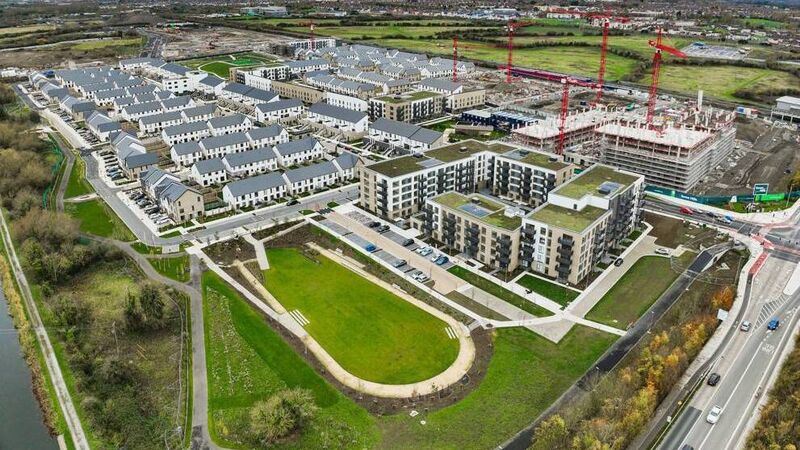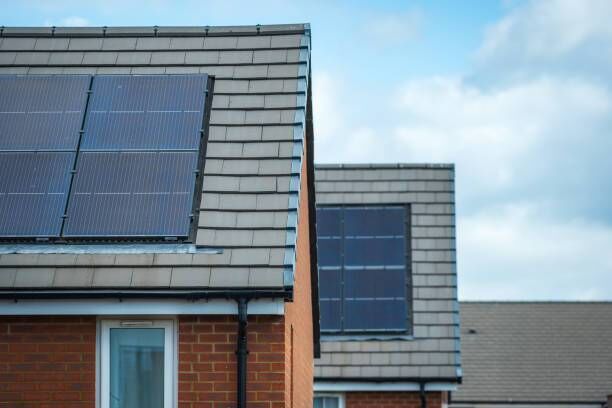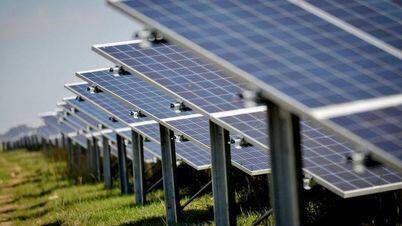Why are we using arable land for solar farms when new rooftops are bare?

Homes at Cairn Homes Seven Mills development are nearly zero energy buildings.
Last week was Green Building Week and much praise was being heaped on Cairn Homes' Seven Mills development in Dublin 22.
The homes are what’s called nearly zero energy buildings, with high energy efficiency, and boast biodiversity crafted landscaping. They look great and the design is commendable.
But what’s immediately striking about the brand new mini town is the absence of solar on the roofs. Why, when Ireland is so far behind its solar energy targets, are we wasting the opportunity to use every roof, every home, and every building surface, as a micro-generator?
Ireland’s solar energy target is to generate 8GW of energy by 2030 — some five times more than we currently do — yet despite that gap, Solar Ireland, the industry network, estimates Ireland has up to a million rooftops suitable for solar generation but sitting idle.
And while the Government is grant-funding solar installations on existing homes, there is no requirement for developers to include solar PV in new homes. At least nine EU countries already have a solar mandate on new buildings, while Belgium, the Netherlands and Switzerland have a mandate on existing buildings.

Sit on a train from Dublin to the Midlands and you can count the solar panel-free roofs in new housing estates that point to an absence of strategy.
While the EU, through the revised Energy Performance of Building Directive, will require all new residential buildings to be optimised for solar energy by January 2030, in Ireland, even ‘green building’ developers are not mapping in solar.
Cairn Homes goes to great lengths to sell its “sustainable” commitment, but while energy efficiency and low carbon construction are very welcome, the absence of energy generation (when it’s so much easier to include at construction) points to a systems failure.
Even passive energy homes require energy, and if the residents end up running an EV car they will need to pull more electricity from the grid. Equally, solar on these low-energy homes means they can return power to the grid and benefit both the residents and the public.
Any roof surface should be seen as a climate solution. Solar PV is an easy addition during, rather than after, construction and an action, if it was mandated now, could dramatically accelerate our solar energy generation and help Ireland meet both energy and climate goals.
Why, when we’re just a few years away from a mandatory solar requirement in new builds, are we still letting developers deliver without it? Government policy should ensure everything being built now is climate future-proofed, supporting decarbonisation and enabling Ireland’s ability to meet its carbon budget. We need to marry energy efficiency with energy generation.

Instead, while Ireland is ignoring the opportunity of unused roof space, both in housing and commercial buildings, we are developing commercial solar farms that often divert arable land into energy generation.
Land is a precious and limited resource — we need land not just for building homes and infrastructure but for new native tree forests, for nature and biodiversity, for restored boglands, and critically for growing food.
And the easiest way, rather than endless retrofitting, is to mandate that any new building is optimised for renewable energy generation. While the roofs of domestic homes are an obvious fit, balconies in apartments are also ideal for solar.
But if some developers are waiting for the EU to mandate solar in their homes, it is good to see local authorities leading on adding solar into the delivery of social homes. Dublin City Council included solar over 10 years ago in the Thornton Heights complex in Inchicore, and it has just published a planning application for 38 apartments in Dublin 12 with heat pumps, solar photovoltaic panels and green/blue roofs.
If Ireland is building a minimum of 30,000 new homes a year (with a need for 50-60,000) and we currently have 140,000 home microgenerations (mostly existing retrofitted homes), mandating solar in new homes approved from 2026 could dramatically accelerate our ability to reach our 2030 solar energy target.
Why wait? In tandem with this, we should prioritise solar installations in existing public buildings, including social housing, and allocated funding so all social homes are rapidly climate-proofed for both energy efficiency and energy generation.
Rather than waiting to fail our 2030 targets and end up paying the long-term costs (in social-economic, environmental consequences) and non-compliance fines, we should, like many of our EU neighbours, start using every roof to help solve our problems and create a better future for all.
- Helen Shaw is a climate solutions researcher and writer. She runs Athena Media and is writer in residence 2025 at the Data Stories Project on housing data in Maynooth University
CLIMATE & SUSTAINABILITY HUB
CONNECT WITH US TODAY
Be the first to know the latest news and updates















